Compression test
We carry out a compression test for a general assessment of the technical condition of the parts of the cylinder-piston group and the valve mechanism of the engine.
We warm up the engine to operating temperature. Relieve pressure in the engine power system (see Fuel filter replacement) and do not replace the fuel pump fuse. Remove the spark plugs from the cylinder head.
Disconnect the engine control wiring harness connectors from the ignition coils.

We install the tip of the compression gauge in the spark plug hole in the cylinder head.
Connect the wire terminal to «negative» battery terminal.
We turn the crankshaft with the starter with the pedal fully depressed «gas» within 2–4 s (the pressure gauge should stop increasing). We fix the pressure gauge reading and release the pressure in the compression gauge.
The battery must be fully charged for a correct compression assessment.
Similarly, we check the compression in other cylinders of the engine.
The compression of a serviceable engine should be in the range of 11.0–13.0 bar, and the difference in readings between the cylinders should not exceed 1.0 bar.
To find out the reasons for low compression, pour 10–15 cm3 of engine oil into the cylinder through the spark plug hole and repeat the measurement.
In the event that the compression increased by more than 2.0 bar during the re-measurement, the most likely cause of the malfunction is severe wear, sticking or breakage of the piston rings. If the pressure gauge readings did not increase after filling the oil, then most likely the valve plates do not fit snugly against the cylinder head seats. This can happen if there is a violation of the thermal gaps in the valve drive, as well as with a lot of wear, burnout or damage to the plates or valve seats. It is possible to finally find out the cause of the malfunction only after disassembling the engine.
Checking the starter enable circuit
If the starter does not work when the key in the ignition switch is turned to the START position, there may be a malfunction of both the starter itself and its switching circuit. We start troubleshooting by checking the fuse «Ef4» (30 A) …
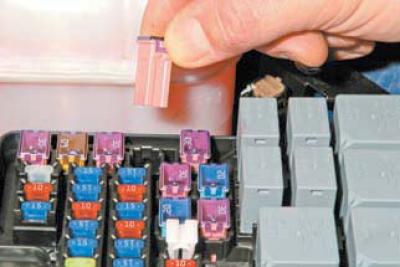
... which is located in the mounting block of the engine compartment.
If the fuse «Ef4» intact - we proceed to check the performance of the starter.
With the ignition off..

... we connect the control output of the traction relay and the tip of the wire coming from «positive» battery outlet.
When carrying out this operation, care must be taken, since sparking is possible in the contact zone of the traction relay outputs with a piece of wire.
Do not short the wire «mass» at the moment of connection of conclusions!
If at the same time the crankshaft rotates, then the starter is working, and the cause of the malfunction is a violation in its switching circuit. Otherwise, the starter or its traction relay is faulty.
If it is not possible to eliminate the malfunction in the switching circuit of a working starter, then, if necessary, in this way (turn on the ignition and connect the leads), you can start the engine and drive to the place of repair.
Checking the ignition coil and its circuits
To check the operation of the ignition coil, we relieve the pressure in the engine power system and do not replace the fuel pump fuse (see Fuel filter replacement). We remove from two spark plugs (serviced by tested coil) tips of high-voltage wires and insert known-good spark plugs into them.
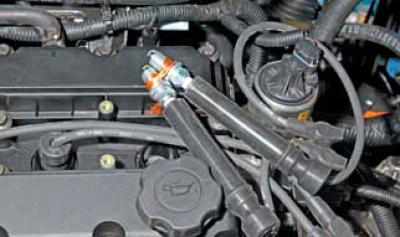
We connect the threaded parts of the candles by wrapping them with bare stranded copper wire.
To avoid electric shock when cranking the crankshaft with a starter, do not touch the spark plugs and high-voltage wire lugs with your hands.
The assistant, turning the key in the ignition switch to the START position, turns the crankshaft.
With serviceable spark plugs, high-voltage wires, the ignition coil and its circuits, sparks should regularly jump between the spark plug electrodes.
If this is not the case, it is necessary to check the power supply and coil control circuits.
To check the power supply circuit of the coil, disconnect the block of the wiring harness of the engine control system from it..
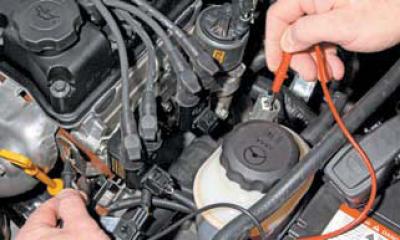
... and connect one tester probe between «weight» motor and output (to which the pink wire is connected) wiring harness pads.
With the ignition on, the device should detect a voltage equal to the voltage at the battery terminals.
If the voltage value is not correct, check the integrity of the fuse «F2» cabin mounting block, as well as the health of the chain (break or short circuit «mass») between the output of the block of the engine management system and the output of the block, which is connected to the contact part of the ignition switch. Please note that this circuit also includes relay K7.
To check the control circuit of the ignition coil, we use a probe with a 1.2 W lamp.
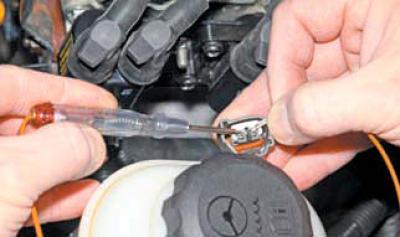
We connect the probe probes to the terminals of the wiring harness block for controlling the ignition coil.
If the control and power circuits of the ignition coil are in good condition, the probe light should flash frequently while cranking the crankshaft with the starter.
Otherwise, we check the circuits between the terminals of the ignition coil and the terminals of the ECU wiring harness block.
If the power and control circuits of the ignition coil are working, but there is no spark when checking the candles (see above), then you should check the coil itself.
To check the ignition coil, measure the resistance..

…primary (1.1 ohm) …
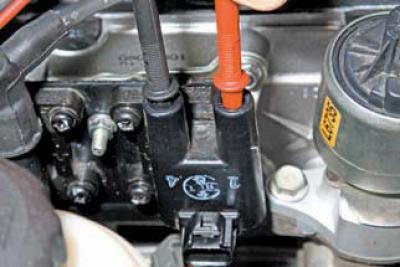
…and secondary (12–13 kΩ) windings.
If there is no spark on the candles, you should also check the condition of the high-voltage wires.
Insulation and wire lugs should not be damaged, and the resistance should fluctuate in the range from 1.7 to 4.0 kOhm, depending on the length of the wire.
Check of a chain of inclusion of the fuel pump
If the fuel pump does not turn on when the ignition is turned on (its operation can be monitored by ear) - a malfunction is possible, both the fuel pump itself and its switching circuit.
We start checking the fuel pump switching circuit by assessing the integrity of the Ef18 fuse (15 A), located in the mounting block of the engine compartment.

We replace the defective fuel pump fuse with a new one, having previously checked whether one of the fuse socket terminals is shorted to «mass».
A malfunction in the fuel pump switching circuit may be caused by damage to the K7 pump relay in the mounting block.
To check the relay..
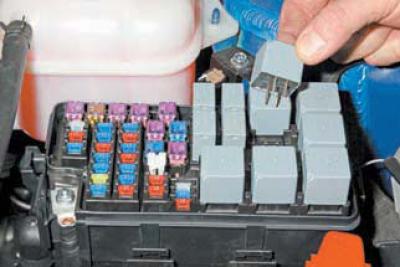
... we remove it from the mounting block and replace it with a known good one.
For this purpose, you can use the K8 power window relay.
If the fuel pump turns on with the newly installed relay, the fuel pump relay is bad and needs to be replaced. Otherwise, check the power circuit and control circuit of the fuel pump relay. To do this, remove the relay from the mounting block.

We measure the voltage between the socket «30» mounting block and «weight».
The device should fix the voltage equal to the voltage of the on-board network. If this is not the case, the mounting block is faulty. We also measure the resistance between the socket «85» mounting block and «weight». With a good circuit «masses» the device should record a resistance of less than 1 ohm.
With the ignition on, measure the voltage between the socket «86» mounting block and «weight».
The device should fix a voltage of about 12 V. If this does not happen, we check the health of the circuit between the socket «86» and the output of the ECU wiring harness block. If the circuit is OK, the ECU is faulty. We install the relay in place and disconnect the wiring harness block from the fuel module.
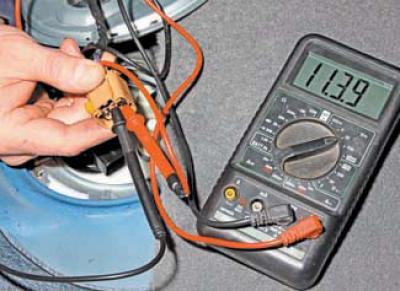
We measure the voltage between the terminals of the gray wire («+» pump power) and adjacent to it «mass» black wires.
When the ignition is turned on for 2 s, the device should detect a voltage equal to the voltage of the on-board circuit. Otherwise, we check the health of the circuits between the socket «87» mounting block and the gray wire outlet of the fuel module wiring harness block, as well as between «weight» and the output of the black wire of the block of the wiring harness of the fuel module.
Checking the pressure in the engine power system
To check the pressure in the fuel rail, you need a tool that you can make yourself. This will require a manometer (e.g. from a tire pump), oil and petrol resistant hose (with inner diameter 8 mm), tee (with outer tube diameter 8 mm) and worm clamps (6 pcs.).
We work on a cold engine. Relieve pressure in the engine power system.

We remove the plastic tube connecting the steel tube that runs under the bottom of the car from the fuel tank and the fuel rail.
We put a hose on the outlet fitting of a steel tube running under the bottom of the car from the fuel tank and fix it with a clamp. We put the other end of the hose on the inlet fitting of the fuel rail and fix it with a clamp. In an accessible place, we cut the hose and install the tee, fixing the hoses on the fittings of the tee with clamps.
We put a piece of hose on the free fitting of the tee, on the other end of which we install a pressure gauge, and fix the hose with clamps.
We turn on the ignition and check the tightness in the connections of the installed device.
We start the engine and when it is idling..

... we measure the fuel pressure in the system, which should be equal to 2.8–3.3 bar.
After stopping the pump, the pressure may decrease slightly and then stabilize for a while. If the pressure in the system is more than 3.3 bar, the fuel pressure regulator is faulty.
Low but stable fuel pressure can be caused by a clogged fuel filter or fuel module strainer, or a malfunctioning fuel pump or fuel pressure regulator. It is better to immediately replace the fuel filter with a new one, which we recommend always having in stock.
If the fuel pressure in the engine supply system is low and continues to drop after the pump is turned off, then the cause of this may be leaks in the connections of the fuel module, a malfunction of the pressure regulator or pump, and leaks in the injectors.
A leaky injector can usually be identified by the dark color of its atomizer, which contains coked fuel droplets.
